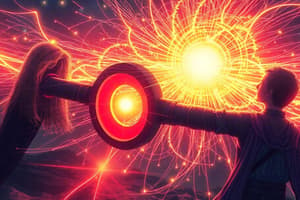Podcast
Questions and Answers
What was the key observation made by Hans Christian Oersted in his experiment?
What was the key observation made by Hans Christian Oersted in his experiment?
- A stationary wire attracts magnetic materials
- A current-carrying wire does not affect a nearby compass.
- A current-carrying wire causes a nearby compass needle to deflect. (correct)
- A current carrying wire stops the compass from working
What shape do the magnetic field lines form around a straight current-carrying wire?
What shape do the magnetic field lines form around a straight current-carrying wire?
- Straight lines parallel to the wire
- Lines that converge towards the wire
- Spirals around the wire
- Concentric circles centered on the wire (correct)
What precaution is mentioned to prevent over-current hazards when recreating Oersted's experiment?
What precaution is mentioned to prevent over-current hazards when recreating Oersted's experiment?
- use air cooled wires only
- Use no more than 10 Amps of current.
- Use a low voltage supply only
- Use a rheostat and appropriately rated wires. (correct)
What does the plotting compass indicate about the magnetic field vector?
What does the plotting compass indicate about the magnetic field vector?
What is the purpose of a rheostat in the experimental setup?
What is the purpose of a rheostat in the experimental setup?
What is the right-hand grip rule used for in the context of magnetic fields from current-carrying wires?
What is the right-hand grip rule used for in the context of magnetic fields from current-carrying wires?
Which of the following is stated as a source of magnetic field deflection, other than a wire carrying current?
Which of the following is stated as a source of magnetic field deflection, other than a wire carrying current?
What does Maxwell's screw rule relate to, in the context of this text?
What does Maxwell's screw rule relate to, in the context of this text?
Flashcards
Magnetic field of a straight current
Magnetic field of a straight current
The magnetic field lines formed around a straight wire carrying current are concentric circles centered on the wire and perpendicular to the wire.
Right-hand grip rule
Right-hand grip rule
The right-hand grip rule states that if you grasp the wire with your right hand, with your thumb pointing in the direction of the conventional current, the direction of the magnetic field lines is given by the direction of your curled fingers.
Oersted's Experiment
Oersted's Experiment
Oersted's experiment demonstrated the connection between electric currents and magnetic fields by showing that a compass needle deflects when placed near a current-carrying wire.
Source of magnetic field
Source of magnetic field
The magnetic field is created by the movement of charges (either positive or negative), not by the wire itself.
Signup and view all the flashcards
Plotting a magnetic field
Plotting a magnetic field
A plotting compass can be used to map out the magnetic field lines around a current-carrying wire by observing the direction of the compass needle at different points.
Signup and view all the flashcards
Maxwell's screw rule
Maxwell's screw rule
The direction of the magnetic field produced by a straight current can be determined by using a right-handed screw rule, where the direction of the screw's rotation corresponds to the direction of the current, and the direction of the screw's advance corresponds to the direction of the magnetic field.
Signup and view all the flashcardsStudy Notes
Magnetic Field by a Straight Current
- Hans Christian Oersted first demonstrated the connection between electric currents and magnetic fields in 1820.
- Field lines around a current-carrying wire form concentric circles in planes perpendicular to the wire.
- To observe this pattern with iron filings, a wire with a large current and running vertically through a horizontal surface needs to be used.
- This setup helps avoid over-current risks, so suitably wired wires and rheostats are used.
- A plotting compass placed on the plane of study demonstrates a consistent magnetic field direction linked to the current's direction.
- This relationship follows the right-hand grip rule.
Oersted's Experiment
- Placing a current-carrying wire near a plotting compass deflects the compass into a plane perpendicular to the wire.
- Replacing the wire with a solution of charged particles (like electrons or alpha particles) causes a similar compass deflection.
- This indicates that the magnetic field is due to the current itself (flow of charge), not the wire material. This generalizes to any electrical current, regardless of the charge carriers (whether negative or positive charges).
Studying That Suits You
Use AI to generate personalized quizzes and flashcards to suit your learning preferences.




